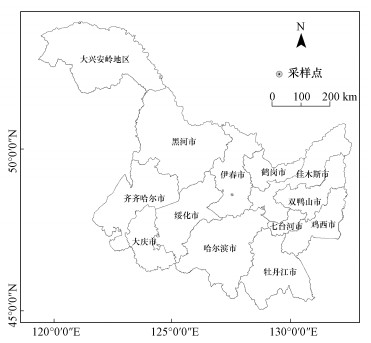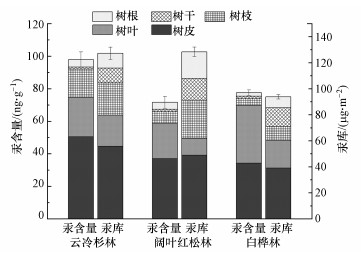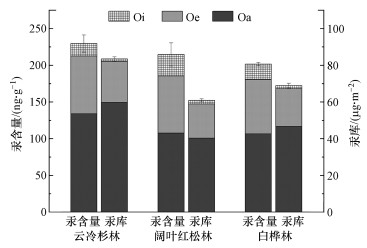 , 王章玮1,2
, 王章玮1,2
 , 徐泽华1,2, 赵庆鹏1,2, 张晓山1,2
, 徐泽华1,2, 赵庆鹏1,2, 张晓山1,21. 中国科学院生态环境研究中心城市与区域生态国家重点实验室, 北京 100085;
2. 中国科学院大学, 北京 100049
收稿日期: 2021-02-18; 修回日期: 2021-03-22; 录用日期: 2021-03-22
基金项目: 国家自然科学基金(No.42077345,42077381)
作者简介: 萨如拉(1995—), 女, E-mail: 18804900391@163.com
通讯作者(责任作者): 王章玮, E-mail: wangzhw@rcees.ac.cn
摘要:植被主要通过叶片气孔吸收大气气态单质汞,森林植被是大气汞重要的汇.量化森林生物质汞库对了解全球汞循环至关重要.为揭示森林乔木层(乔木层分为树干、树叶、树枝、树根和树皮)、灌木层、草本层和凋落物层(凋落物层分为未分解层(Oi)、半分解层(Oe)和已分解层(Oa))汞含量和汞库分配,本研究选取黑龙江省凉水自然保护区小兴安岭原始林阔叶红松林、次生原始林云冷杉林和次生原始林白桦林3种原始林开展植物和凋落物汞含量和汞库调查.结果表明,乔木层各组织中汞含量遵循树皮>树叶>树枝>树根>树干的规律,云冷杉林乔木层汞含量总体上高于阔叶红松林及白桦林乔木层汞含量.凋落物中汞含量排序为Oa > Oe > Oi,原始林阔叶红松林凋落物汞含量高于次生原始林白桦林凋落物汞含量,但低于次生原始林云冷杉林凋落物汞含量.进一步估算生物质总汞库发现云冷杉林、阔叶红松林和白桦林分别为212、192和163 μg·m-2.乔木层地上部分是森林生物质汞库的主体,其树皮汞库占总汞库的37.4%~43.5%,灌木层和草本层仅占总汞库的1%左右.本研究可为进一步评估森林生态系统在大气汞循环中的作用及预测森林火灾发生时生物质燃烧汞释放潜势提供基础数据.
关键词:森林生物质汞汞含量汞库小兴安岭
Distribution characteristics of mercury concentration and estimation biomass mercury pools in different natural forests of Xiaoxing'an Mountain
Sarula1,2
 , WANG Zhangwei1,2
, WANG Zhangwei1,2
 , XU Zehua1,2, ZHAO Qingpeng1,2, ZHANG Xiaoshan1,2
, XU Zehua1,2, ZHAO Qingpeng1,2, ZHANG Xiaoshan1,21. State Key Laboratory of Urban and Regional Ecology, Research Center for Eco-Environmental Sciences, Chinese Academy of Sciences, Beijing 100085;
2. University of Chinese Academy of Sciences, Beijing 100049
Received 18 February 2021; received in revised from 22 March 2021; accepted 22 March 2021
Abstract: Forests are important atmospheric mercury sink for absorbing atmospheric gaseous elemental mercury through leaf stomata. Quantifying forest biomass mercury pools are critical to understanding the global mercury cycle. In order to reveal mercury concentration and distribution characteristics of mercury pools in natural forest, samples from tree layer (bole, leaves, branches, roots and bark), shrub layer, herb layer and litter layer (undecomposed surface litter (Oi), partially decomposed litter (Oe) and decomposed organic humus (Oa)) were collected in mixed old-growth forest, secondary spruce-fir forest and secondary birch forest at the Xiaoxing'an Mountain located in the Liangshui National Nature Reserve in Heilongjiang Province, and mercury concentrations were analyzed using a direct mercury analyzer. The results showed that the concentration of mercury in tree layer was higher in spruce-fir forest than that of mixed forest and birch forest, where mercury concentrations in different tissues followed the order of bark > leaves > branches > roots > bole. In litter layer, the highest mercury concentration was found in Oa followed by Oe and Oi. Mercury concentration of litter layer in the mixed old-growth forest was higher than that of secondary birch forest, and lower than that of secondary spruce-fir forest. Furthermore, total biomass mercury pool was estimated to be 212 μg·m-2 in spruce-fir forest, 192 μg·m-2 in mixed forest and 163 μg·m-2 in birch forest, respectively. Mercury stores in the bark of tree layer accounted for 37.4%~43.5% of the total mercury pools, and yet those from the shrub layer and herb layer only accounted for about 1.00%. These obtained results are quite valuable for further assessing the role of forest ecosystems in the atmospheric mercury cycle and predicting the mercury release potential of biomass combustion during forest wildfires.
Keywords: forestbiomass mercurymercury concentrationmercury poolXiaoxing'an Mountain
1 引言(Introduction)汞是一种全球性的污染物, 可通过水生和陆生食物链富集对人体健康造成威胁(Wheatley et al., 2000).汞在大气中有3种形态: 气态单质汞(Hg0)、活性气态汞(Hg(Ⅱ))和颗粒态汞(Hg(p)).其中, 气态单质汞占总汞的95%, 在大气中可停留6~24个月, 能够进行全球性传输, 而颗粒态和活性气态汞在大气中滞留时间短, 主要在源区附近沉降.近几十年经济持续增长, 使我国成为了汞排放大国, 全球人为源汞排放清单的计算结果表明, 中国大气汞排放量占全球大气汞排放量的28%(Pacyna et al., 2006);但不可忽略的是, 我国境内每年从大气沉降到陆地生态系统表面的汞高达75.9 t(Chen et al., 2020).
植物地上部分汞来源有: ①通过根部从土壤吸收后转运至地上部分(Ericksen et al., 2006; Luo et al., 2016);②通过植物叶面气孔的呼吸作用从大气中直接吸收Hg0和甲基汞(王训等, 2017; Wang et al., 2018);③通过植物叶片从大气中吸附沉降到叶片表面的二价汞或颗粒态汞.现有大量的野外观测(Assad et al., 2016; Peckham et al., 2019)和现场模拟实验(Ericksen et al., 2003; Frescholtz et al., 2003)表明, 植物主要通过叶片气孔吸收大气气态单质汞, 造成树叶和凋落物中高汞含量的现象(Fleck et al., 1999; Obrist et al., 2009; Zhou et al., 2016), 使得森林植被成为大气汞重要的汇(Wang et al., 2009; Zhou et al., 2018).但目前人们对汞在不同林分乔木层(乔木层分为树干、树叶、树枝、树根和树皮)、灌木层、草本层和凋落物层(凋落物层分为未分解层(Oi)、半分解层(Oe)和已分解层(Oa))中分配特征及分配规律研究还十分欠缺.更重要的是, 随着全球变暖, 森林火灾频发, 森林植被从大气中吸收的汞会随生物质燃烧重新排放到大气中影响全球大气汞循环.因此, 弄清森林尤其天然林不同林分汞的分布特征和规律, 量化森林乔木层、灌木层、草本层和凋落物层汞库, 是评估森林生态系统在大气汞循环中作用的基础, 也是预测森林火灾发生时, 生物质燃烧过程汞释放潜势的关键.
中国东北的温带森林是亚洲最大的温带混交林, 占中国森林资源(在面积和储量上)的1/3以上(Wang, 2006), 在我国甚至全球汞生物地球化学和气候系统中发挥着重要作用.为了调查东北温带森林生物质汞分布规律, 本研究选取小兴安岭主要原始林(即云冷杉林、阔叶红松林和白桦林), 量化不同树种的树叶、树干、树皮、树枝、树根、灌木层、草本层和凋落物层汞含量及对应汞库, 并比对3个原始林生物质总汞库, 分析汞库分配比例, 以期为进一步深入研究森林生态系统在全球大气汞循环中的作用提供基础数据支撑.
2 研究区概况与方法(Study area and methods)2.1 研究区概况研究区(图 1)位于黑龙江省伊春市带岭区的凉水国家级自然保护区(47°11′N, 128°52′~128°54′E), 海拔在352~475 m, 地处小兴安岭南坡, 为北温带湿润气候区, 夏季最温度为38 ℃, 年极端最低温度为-43.9 ℃, 年均气温为0 ℃左右, 年降水量为676 mm, 无霜期为120 d, 土壤主要为暗棕壤, 地处我国温带典型的针阔混交林—阔叶红松林的中心分布区.1950年之前, 该地区主要森林类型是阔叶红松林;1950年初, 该区域发生了大规模的砍伐性活动, 一部分阔叶红松林被次生原始林云冷杉林、白桦林及人工林所取代.本研究选取东北山区典型的原始林阔叶红松林、次生原始林云冷杉林及白桦林为研究对象, 林分主要树种为红松、冷杉、云杉和白桦, 并伴有五角槭、杨树、椴树和兴安落叶松等树种.
图 1(Fig. 1)
 |
| 图 1 小兴安岭天然林采样地点图 Fig. 1Map of sampling location for natural forests in Xiaoxing′an Mountain |
2.2 样品采集与分析本研究选取一年中树叶成熟季节(9月末)采集样品, 在阔叶红松林、云冷杉林和白桦林分别布设10 m×10 m样地, 每个样地3个重复, 样地间有100 m缓冲带.每个样地分乔木层、灌木层和草本层.林冠层选取红松、五角槭、云杉、冷杉和白桦树, 分别采集树叶、树枝、树根、树皮和树芯样品.利用瑞典Haglof生长锥采集树芯样品, 每个树种选取3颗长势良好的树木(避免选择树体弯曲偏扭和发生病腐的树木), 每棵树采集2个树芯.将每棵树木所采集的树芯样本分别置于塑料管中, 放在-15 ℃冰箱中保存, 运回实验室后于65 ℃烘箱中烘干, 将一棵树采集的树芯全部混合为一个样品研磨(高速万能粉碎机FW100)供测定分析.在样地内设随机分布的3个1 m×1 m的样方, 用破坏性全部收获的方式采集样方内所有的灌木和草本.灌木层采集到的物种包括东北山梅花、珍珠梅、疣枝卫矛和毛榛等, 草本层采集到的物种包括苔草、木贼和粗茎鳞毛蕨等;将根、茎和叶样品合并处理, 未进行组织区分.此外, 每个样地设置3个20 cm×20 cm小样方, 采集未分解层(Oi)、半分解层(Oe)和已分解层(Oa)的凋落物样品.其中, 未分解层凋落物选取新鲜的、颜色变化不明显、质地坚硬、外表无分解痕迹的凋落物;半分解层凋落物选取叶无完整外观轮廓、多数凋落物已粉碎、叶肉成碎屑的凋落物;已分解层凋落物选取不能辨识枝叶原形、颜色呈黑褐色的凋落物.所有植物和凋落物样品采集后, 立即带回实验室进行前处理, 对植物样品根进行清洗, 其余样品不进行清洗, 然后将所有样品置于65 ℃烘箱中烘干, 粉碎(高速万能粉碎机FW100)供测定分析.
利用直接测汞仪DMA80(Milestone DMA-80, 美国)测定植物和凋落物样品汞含量, 该仪器使用纳米级金汞齐富集技术, 配合高解析速率, 充分保证吸收峰型, 以获得优异的准确度和精密度, 仪器总汞检测限为0.34 ng·g-1.测定过程中的质量控制和质量保证采用随机重复、基本加标和标准物质测定来控制.利用茶树叶(GBW08001, 17 ng·g-1)进行标准曲线测定, 其覆盖样品测定值范围且相关性达0.999后才开始测定样品.每个样品测两次, 且平行样品汞含量差异<10%.每6个样品加入一个标准参考物质测量, 保证校正因子F在0.9~1.1区间.
2.3 汞库估算方法汞库计算可通过汞含量和相应组分生物量(干重)相乘获得.本研究中原始林阔叶红松林、次生原始林云冷杉林及白桦林的林冠层树干、树根、树枝和树叶, 以及灌木层、草本层的生物量(干重)和凋落物层现有储存量(干重)引自蔡慧颖等的研究结果(Cai et al., 2016; 蔡慧颖等, 2014).树干和树皮生物量的分配比例王飞等(2013)的研究结果.森林生态系统汞库通过式(1)估算(Zhou et al., 2016):
 | (1) |
3 结果与讨论(Results and discussion)3.1 植被层生物质汞含量和汞库小兴安岭天然原始林阔叶红松林、次生原始林云冷杉林及白桦林的乔木层各组织汞含量见表 1和图 2.由表 1和图 2可见, 3种林分乔木层各组织中汞含量为树皮和树叶最高, 树枝和树根次之, 树干最低.已有大量的野外观测和现场模拟实验表明, 乔木冠层中的汞主要来自叶片气孔吸收的大气中的气态单质汞(Ericksen et al., 2003; Frescholtz et al., 2003; Gustin et al., 2008; Niu et al., 2011).树皮中的高汞含量则说明树皮也会像树叶一样吸附并积累大气汞(Chiarantini et al., 2016; Yang et al., 2018), 并且树皮中的汞很少传输到树干中, 由此导致树干组织是汞含量最低的组织(Chiarantini et al., 2016; Peckham et al., 2019).本研究中树皮的汞含量比以往研究中的汞含量高, 这可能跟很多研究中对树皮进行清洗, 洗去了表面吸附的汞有关(Yang et al., 2018).
表 1(Table 1)
| 表 1 乔木层各组织生物量和汞含量 Table 1 Mercury concentrations in biomass and biomass in various tissues of overstory | |||||||||||||||||||||||||||||||||||||||||||||||||||||||||||||||||||||||
表 1 乔木层各组织生物量和汞含量 Table 1 Mercury concentrations in biomass and biomass in various tissues of overstory
| |||||||||||||||||||||||||||||||||||||||||||||||||||||||||||||||||||||||
图 2(Fig. 2)
 |
| 图 2 乔木层各组织生物质汞含量和汞库 Fig. 2Biomass mercury concentrations and corresponding biomass mercury pools in various tissues of overstory |
本研究与国内其他背景地区相比, 小兴安岭3种原始林新鲜树叶中汞含量低于贡嘎山新鲜树叶中汞含量(44.0~80.0 ng·g-1) (李芬等, 2017);比我国汞污染地区重庆市铁山坪树叶中的汞含量(78.0~244 ng·g-1)低8倍左右(Zhou et al., 2016);与欧洲和美国大部分地区树叶中汞含量(10.0~50.0 ng·g-1)(Grigal, 2003; Reimann et al., 2007; Blackwell et al., 2015a)一致;但高于报道中加拿大树叶汞含量(3.30~15.9 ng·g-1), 这可能与采集季节不同有关(Siwik et al., 2010);小兴安岭森林平均树干汞含量低于美国东北部和西部森林树干汞含量(Engle et al., 2006; Yang et al., 2018), 与加拿大东南部森林树干汞含量一致(Siwik et al., 2010).
已有研究表明, 不同树种各组织对汞的吸收有差异(Juillerat et al., 2012; Richardson et al., 2015), 针叶树种汞含量比阔叶树种汞含量高(Obrist et al., 2012; Yang et al., 2018).但本研究中白桦树叶汞平均含量为(32.2±4.72) ng·g-1, 冷杉针叶汞平均含量为(23.5±4.07) ng·g-1, 这可能是因为除了不同植被对大气汞的吸收有差异以外, 不同树种树叶之间的生理差异, 比如气孔数量与形状、叶片粗糙度和叶面积指数等也会影响叶片对大气汞的吸收(Niu et al., 2011; Obrist et al., 2012; Richardson et al., 2015);且不同树种树皮中汞含量也不尽相同, 五角槭和白桦树皮中汞含量分别为(31.3±5.47) ng·g-1和(40.8±9.17) ng·g-1, 云杉和红松树皮中汞含量分别为(58.7±3.56) ng·g-1和(65.6±8.34) ng·g-1.不同树种各组织汞含量差异可能与树冠的高低、几何形态及生理学有关(Obrist et al., 2012).
树叶和树皮中汞含量会随着暴露时间的延长而逐渐增加, 这种线性关系表明, 树叶和树皮中汞含量的积累是受大气间的传质过程决定的(Bushey et al., 2008; Laacouri et al., 2013; Assad et al., 2016).本研究中小兴安岭天然原始林阔叶红松林、次生原始林云冷杉林及白桦林各组织生物量见表 1, 根据测定生物质汞含量获得的小兴安岭天然原始林阔叶红松林、次生原始林云冷杉林及白桦林的乔木层各组织汞库见图 2.从图中可以看出, 3种林分乔木层中各组织汞库分布为树皮(39.1~55.8 μg·m-2)和树枝(10.7~29.3 μg·m-2)最高, 树叶(13.0~24.0 μg·m-2)次之, 树干(11.3~16.7 μg·m-2)和树根(8.41~20.5 μg·m-2)最低.云冷杉林、阔叶红松林和白桦林乔木层总汞库分别为127、128和93.8 μg·m-2.虽然树叶汞含量高, 但由于生物量低, 汞库仅占乔木层总汞库的10.11%~22.69%.乔木层地上部分汞库是地下部分汞库的5~10倍, 植物地上部分主要通过植物叶面气孔的呼吸作用从大气中吸收汞, 地下部分通过蒸腾作用从土壤溶液中吸收汞(王训等, 2017), 由此小兴安岭乔木层成为重要的大气汞汇.
小兴安岭天然原始林阔叶红松林、次生原始林云冷杉林及白桦林的灌木层汞含量和汞库见图 3a.3种林分灌木层平均汞含量分别为云冷杉林(2.33±1.10) ng·g-1、阔叶红松林(11.5±3.12) ng·g-1和白桦林(11.6±5.95) ng·g-1.不同灌木物种中的汞含量分别为珍珠梅(2.33±3.20) ng·g-1、瘤枝卫矛(10.2±4.72) ng·g-1、毛榛(13.7±18.7) ng·g-1和东北山梅花(10.7±3.70) ng·g-1.云冷杉林、阔叶红松林和白桦林中灌木的生物量分别为0.63、0.22和0.23 kg·m-2(蔡慧颖等, 2014; Cai et al., 2016), 云冷杉林、阔叶红松林和白桦林汞库分别为0.147、0.254和0.286 μg·m-2(图 3a).
图 3(Fig. 3)
 |
| 图 3 灌木层(a)和草本层(b)生物质汞含量和汞库 Fig. 3Biomass mercury concentrations and corresponding biomass mercury pools in shrub(a) and herb(b) |
小兴安岭天然原始林阔叶红松林、次生原始林云冷杉林及白桦林的草本层汞含量和汞库见图 3b.3种林分草本层平均汞含量分别为云冷杉林(29.0±8.80) ng·g-1、阔叶红松林(51.9±47.7) ng·g-1和白桦林(18.7±15.7) ng·g-1.不同草本物种中的汞含量分别为大车前草(36.2±3.74) ng·g-1、乌苏里苔草(12.8±8.34) ng·g-1、和尚菜(37.2±3.12) ng·g-1、木贼(10.9±6.51) ng·g-1、粗茎鳞毛蕨(34.3±8.74) ng·g-1和卷柏(104±10.8) ng·g-1.部分蕨类植物中测到高汞含量, 可能与蕨类植物草本气孔比被子植物草本气孔大有关(熊慧等, 2014), 但不同蕨类植物对大气汞的吸收差异需要更详细的研究.云冷杉林、阔叶红松林和白桦林中草本的生物量分别为0.30、0.41和0.25 kg·m-2.云冷杉林、阔叶红松林和白桦林草本层总汞库分别为0.861、2.11和0.463 μg·m-2(图 3b).
3.2 凋落物汞含量和汞库凋落物沉降是森林生态系统大气汞输入的主要途径(Wang et al., 2009).小兴安岭天然原始林阔叶红松林、次生原始林云冷杉林及白桦林的凋落物层汞含量和汞库见图 4.由图可见, 3种林分凋落物层汞含量分别为17.1~29.2 ng·g-1(未分解层)、74.0~78.6 ng·g-1(半分解层)和107~134 ng·g-1(已分解层).本研究中凋落物汞含量比欧洲西南地区调查结果高(Gomez-Armesto et al., 2020), 但远低于国内汞污染地区(Zhou et al., 2016)和国外汞污染地区凋落物汞含量(Demers et al., 2007; Richardson et al., 2015; Navratil et al., 2016).未分解层凋落物汞含量与乔木层树叶中汞含量一致, 半分解层凋落物和已分解层凋落物汞含量均比乔木层各组织、灌木层和草本层汞含量高, 这与已有研究结论凋落物中的汞含量随着未分解层、半分解层和已分解层逐步升高(Navratil et al., 2014; Blackwell et al., 2015b; Gomez-Armesto et al., 2020)一致.随着凋落物的分解, 有机质含量逐渐增加, 可以有效吸收穿透水沉降到森林生态系统中的汞, 并且随着有机质增加, 吸附汞的基团也增加, 有效降低了汞在有机碳分级过程中的流失(Obrist et al., 2009; Zhou et al., 2018).
图 4(Fig. 4)
 |
| 图 4 凋落物层中的汞含量和汞库 Fig. 4Mercury concentrations and corresponding mercury pools in litterfall |
3种林分凋落物现存生物量为0.68~0.81 kg·m-2(蔡慧颖等, 2014; Cai et al., 2016).云冷杉林、阔叶红松林和白桦林凋落物层总汞库分别为83.4、60.9和68.9 μg m-2(图 4).云冷杉林凋落物层总汞库最大, 这主要是因为云冷杉林已分解层凋落物中汞含量比阔叶红松林及白桦林凋落物汞含量高.小兴安岭天然林凋落物层汞库与北京东灵山地区凋落物层汞库相近(Zhou et al., 2017), 低于我国汞污染地区凋落物层汞库(Zhou et al., 2016), 远低于捷克针叶林凋落物层汞库(5300~10100 μg·m-2)(Navratil et al., 2014), 高于欧洲西南部地区森林凋落物层汞库(Gomez-Armesto et al., 2020).
3.3 林分植物中汞库分配将3个林分乔木层、灌木层和草本层汞库合并可获得植物生物质总汞库, 分别为云冷杉林128 μg·m-2、阔叶红松林131 μg·m-2和白桦林94.6 μg·m-2.林分和不同组分汞库分配见图 5.小兴安岭天然林乔木层汞库中, 树皮汞库占总汞库的37.4%~43.5%;虽然树叶直接吸收大气中的汞, 但由于生物量低, 汞库仅占总汞库的9.93%~22.5%;其次是树枝和树干, 分别占总汞库的11.3%~22.4%和8.84%~15.2%, 这与树木各组织中的汞很少会转移到树干中的结论一致(Schwesig et al., 2003);树根中的汞含量占森林总汞库的8.86%~15.6%.相较于乔木层, 小兴安岭天然林灌木层和草本层生物量很低, 仅占总汞库的1%左右, 但东北森林草本层中有着丰富的蕨类植物且汞含量高, 因此, 草本层汞库比灌木层汞库高.原始林被次生原始林取代对大气汞的吸收变化是不一的, 次生原始林云冷杉林植物生物质总汞库与原始林阔叶红松林相差不大, 但次生原始林白桦林对大气汞的吸收能力比原始林阔叶红松林明显变少.但需要注意的是, 林分植物中的汞库取决于该林分植物中所含的汞含量和其生物量, 因此, 不同地点的不同林分汞库都各不相同, 而本文中植物的汞含量除了根以外都算上了样品表面吸附的汞.本研究获得的林分生物质汞库分配为进一步深入评估森林生态系统在大气汞循环中的作用及估算自然源汞排放有重要的现实意义.
图 5(Fig. 5)
 |
| 图 5 云冷杉林、阔叶红松林和白桦林生物质汞库分配 Fig. 5Distribution of the biomass mercury pools in spruce-fir forests, mixed forests and birch forests |
4 结论(Conclusions)本研究选取黑龙江省伊春市带岭区的凉水国家级自然保护区天然原始林阔叶红松林、次生原始林云冷杉林及白桦林开展乔木层、灌木层、草本层和凋落物层中汞含量和汞库的调查研究.结果表明, 乔木层中汞含量会随着不同树木组织而变化, 在3种林分中各组织汞含量遵循树皮>树叶>树枝>树根>树干的规律.凋落物层中的汞含量随着未分解层Oi、半分解层Oe和已分解层Oa逐渐升高.云冷杉林、阔叶红松林和白桦林中的总汞库分别为212、192和163 μg m-2.乔木层中的树皮汞库占总汞库的37.43%~43.51%, 灌木层和草本层仅占总汞库的1%左右.小兴安岭原始林是重要的大气汞汇, 对其进行生物质汞库研究可为进一步评估森林生态系统在大气汞循环中作用及预测森林野火发生时生物质燃烧汞释放潜势提供基础.
参考文献
| Assad M, Parelle J, Cazaux D, et al. 2016. Mercury uptake into poplar leaves[J]. Chemosphere, 146: 1-7. DOI:10.1016/j.chemosphere.2015.11.103 |
| Blackwell B D, Driscoll C T. 2015a. Using foliar and forest floor mercury concentrations to assess spatial patterns of mercury deposition[J]. Environmental Pollution, 202: 126-134. DOI:10.1016/j.envpol.2015.02.036 |
| Blackwell B D, Driscoll C T. 2015b. Deposition of mercury in forests along a montane elevation gradient[J]. Environmental Science & Technology, 49(9): 5363-5370. |
| Bushey J T, Nallana A G, Montesdeoca M R, et al. 2008. Mercury dynamics of a northern hardwood canopy[J]. Atmospheric Environment, 42(29): 6905-6914. DOI:10.1016/j.atmosenv.2008.05.043 |
| Cai H, Di X, Chang S X, et al. 2016. Carbon storage, net primary production, and net ecosystem production in four major temperate forest types in northeastern China[J]. Canadian Journal of Forest Research, 46(2): 143-151. DOI:10.1139/cjfr-2015-0038 |
| Chen L, Liang S, Zhang H, et al. 2020. Rapid increase in cement-related mercury emissions and deposition in China during 2005-2015[J]. Environmental Science & Technology, 54(22): 14204-14214. |
| 蔡慧颖, 邸雪颖, 金光泽, 等. 2014. 小兴安岭谷地云冷杉林的碳密度与生产力[J]. 应用生态学报, 25(10): 2794-2802. |
| Chiarantini L, Rimondi V, Benvenuti M, et al. 2016. Black pine (Pinus nigra) barks as biomonitors of airborne mercury pollution[J]. Science of the Total Environment, 569: 105-113. |
| Demers J D, Driscoll C T, Fahey T J, et al. 2007. Mercury cycling in litter and soil in different forest types in the Adirondack region, New York, USA[J]. Ecological Applications, 17(5): 1341-1351. DOI:10.1890/06-1697.1 |
| Engle M A, Gustin M S, Goff F, et al. 2006. Atmospheric mercury emissions from substrates and fumaroles associated with three hydrothermal systems in the western United States[J]. Journal of Geophysical Research-Atmospheres, 111(D17): 16. |
| Ericksen J A, Gustin M S, Schorran D E, et al. 2003. Accumulation of atmospheric mercury in forest foliage[J]. Atmospheric Environment, 37(12): 1613-1622. DOI:10.1016/S1352-2310(03)00008-6 |
| Ericksen J A, Gustin M S, Xin M, et al. 2006. Air-soil exchange of mercury from background soils in the United States[J]. Science of the Total Environment, 366(2/3): 851-863. |
| Fleck J A, Grigal D F, Nater E A. 1999. Mercury uptake by trees: An observational experiment[J]. Water Air and Soil Pollution, 115(1/4): 513-523. DOI:10.1023/A:1005194608598 |
| Frescholtz T F, Gustin M S, Schorran D E, et al. 2003. Assessing the source of mercury in foliar tissue of quaking aspen[J]. Environmental Toxicology and Chemistry, 22(9): 2114-2119. DOI:10.1002/etc.5620220922 |
| Gomez-Armesto A, Mendez-Lopez M, Perez-Rodriguez P, et al. 2020. Litterfall Hg deposition to an oak forest soil from southwestern Europe[J]. Journal of Environment Management, 269: 110858. |
| Grigal D F. 2003. Mercury sequestration in forests and peatlands: A review[J]. Journal of Environmental Quality, 32(2): 393-405. |
| Gustin M S, Lindberg S E, Weisberg P J. 2008. An update on the natural sources and sinks of atmospheric mercury[J]. Applied Geochemistry, 23(3): 482-493. DOI:10.1016/j.apgeochem.2007.12.010 |
| Juillerat J I, Ross D S, Bank M S. 2012. Mercury in litterfall and upper soil horizons in forested ecosystems in Vermont, USA[J]. Environmental Toxicology and Chemistry, 31(8): 1720-1729. DOI:10.1002/etc.1896 |
| Laacouri A, Nater E A, Kolka R K. 2013. Distribution and uptake dynamics of mercury in leaves of common deciduous tree species in Minnesota, U.S.A[J]. Environmental Science & Technology, 47(18): 10462-10470. |
| Luo Y, Duan L, Driscoll C T, et al. 2016. Foliage/atmosphere exchange of mercury in a subtropical coniferous forest in south China[J]. Journal of Geophysical Research-Biogeosciences, 121(7): 2006-2016. DOI:10.1002/2016JG003388 |
| 李芬, 王训, 罗辑, 等. 2017. 1999年与2014年贡嘎山峨眉冷杉枝和叶中常见重金属的生物富集特征对比[J]. 环境科学, 38(Issue): 3045-3053. |
| Navratil T, Shanley J, Rohovec J, et al. 2014. Distribution and pools of mercury in Czech forest soils[J]. Water Air and Soil Pollution, 225(3). DOI:10.1007/s11270-013-1829-1 |
| Navratil T, Shanley J B, Rohovec J, et al. 2016. Soil mercury distribution in adjacent coniferous and deciduous stands highly impacted by acid rain in the Ore Mountains, Czech Republic[J]. Applied Geochemistry, 75: 63-75. DOI:10.1016/j.apgeochem.2016.10.005 |
| Niu Z, Zhang X, Wang Z, et al. 2011. Mercury in leaf litter in typical suburban and urban broadleaf forests in China[J]. Journal of Environmental Sciences, 23(12): 2042-2048. DOI:10.1016/S1001-0742(10)60669-9 |
| Obrist D, Johnson D W, Edmonds R L. 2012. Effects of vegetation type on mercury concentrations and pools in two adjacent coniferous and deciduous forests[J]. Journal of Plant Nutrition and Soil Science, 175(1): 68-77. DOI:10.1002/jpln.201000415 |
| Obrist D, Johnson D W, Lindberg S E. 2009. Mercury concentrations and pools in four Sierra Nevada forest sites, and relationships to organic carbon and nitrogen[J]. Biogeosciences, 6(5): 765-777. DOI:10.5194/bg-6-765-2009 |
| Pacyna E G, Pacyna J M, Steenhuisen F, et al. 2006. Global anthropogenic mercury emission inventory for 2000[J]. Atmospheric Environment, 40(22): 4048-4063. DOI:10.1016/j.atmosenv.2006.03.041 |
| Peckham M A, Gustin M S, Weisberg P J, et al. 2019. Results of a controlled field experiment to assess the use of tree tissue concentrations as bioindicators of air Hg[J]. Biogeochemistry, 142(2): 265-279. DOI:10.1007/s10533-018-0533-z |
| Reimann C, Arnoldussen A, Finne T E, et al. 2007. Element contents in mountain birch leaves, bark and wood under different anthropogenic and geogenic conditions[J]. Applied Geochemistry, 22(7): 1549-1566. DOI:10.1016/j.apgeochem.2007.03.048 |
| Richardson J B, Friedland A J. 2015. Mercury in coniferous and deciduous upland forests in northern New England, USA: implications of climate change[J]. Biogeosciences, 12(22): 6737-6749. DOI:10.5194/bg-12-6737-2015 |
| Schwesig D, Krebs O. 2003. The role of ground vegetation in the uptake of mercury and methylmercury in a forest ecosystem[J]. Plant and Soil, 253(2): 445-455. DOI:10.1023/A:1024891014028 |
| Siwik E I H, Campbell L M, Mierle G. 2010. Distribution and trends of mercury in deciduous tree cores[J]. Environmental Pollution, 158(6): 2067-2073. DOI:10.1016/j.envpol.2010.03.002 |
| Wang C K. 2006. Biomass allometric equations for 10 co-occurring tree species in Chinese temperate forests[J]. Forest Ecology and Management, 222(1/3): 9-16. |
| Wang Z W, Sun T, Driscoll C T, et al. 2018. Mechanism of accumulation of methylmercury in rice(Oryza sativa L.) in a mercury mining area[J]. Environmental Science & Technology, 52(17): 9749-9757. |
| Wang Z, Zhang X, Xiao J, et al. 2009. Mercury fluxes and pools in three subtropical forested catchments, southwest China[J]. Environmental Pollution, 157(3): 801-808. DOI:10.1016/j.envpol.2008.11.018 |
| Wheatley B, Wheatley M A. 2000. Methylmercury and the health of indigenous peoples: a risk management challenge for physical and social sciences and for public health policy[J]. Science of the Total Environment, 259(1/3): 23-29. |
| 王飞. 2013. 兴安落叶松天然林碳密度与碳平衡研究[D]. 呼和浩特: 内蒙古农业大学. 33-34 |
| 王训, 袁巍, 冯新斌. 2017. 森林生态系统汞的生物地球化学过程[J]. 化学进展, 29(9): 970-980. |
| 熊慧, 马承恩, 李乐, 等. 2014. 不同生境条件下蕨类和被子植物的气孔形态特征及其对光强变化的响应[J]. 植物生态学报, 38(8): 868-877. |
| Yang Y, Yanai R D, Driscoll C T, et al. 2018. Concentrations and content of mercury in bark, wood, and leaves in hardwoods and conifers in four forested sites in the northeastern USA[J]. Plos One, 13(4): 14. |
| Zhou J, Wang Z, Sun T, et al. 2016. Mercury in terrestrial forested systems with highly elevated mercury deposition in southwestern China: The risk to insects and potential release from wildfires[J]. Environmental Pollution, 212. |
| Zhou J, Wang Z W, Zhang X S. 2018. Deposition and fate of mercury in litterfall, litter, and soil in coniferous and broad-leaved forests[J]. Journal of Geophysical Research-Biogeosciences, 123(8): 2590-2603. DOI:10.1029/2018JG004415 |
| Zhou J, Wang Z, Zhang X, et al. 2017. Mercury concentrations and pools in four adjacent coniferous and deciduous upland forests in Beijing, China[J]. Journal of Geophysical Research: Biogeosciences, 122(5): 1260-1274. DOI:10.1002/2017JG003776 |
